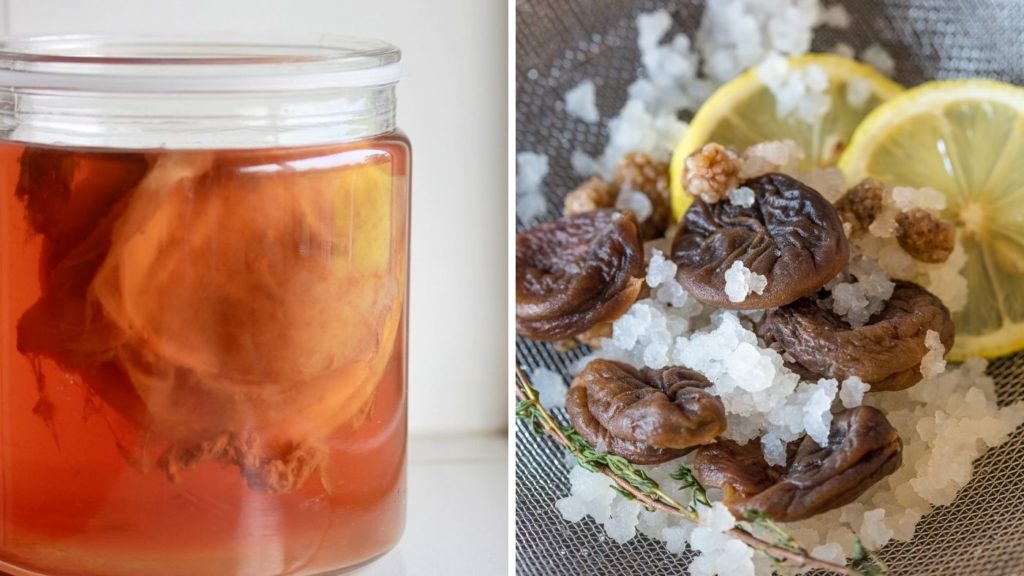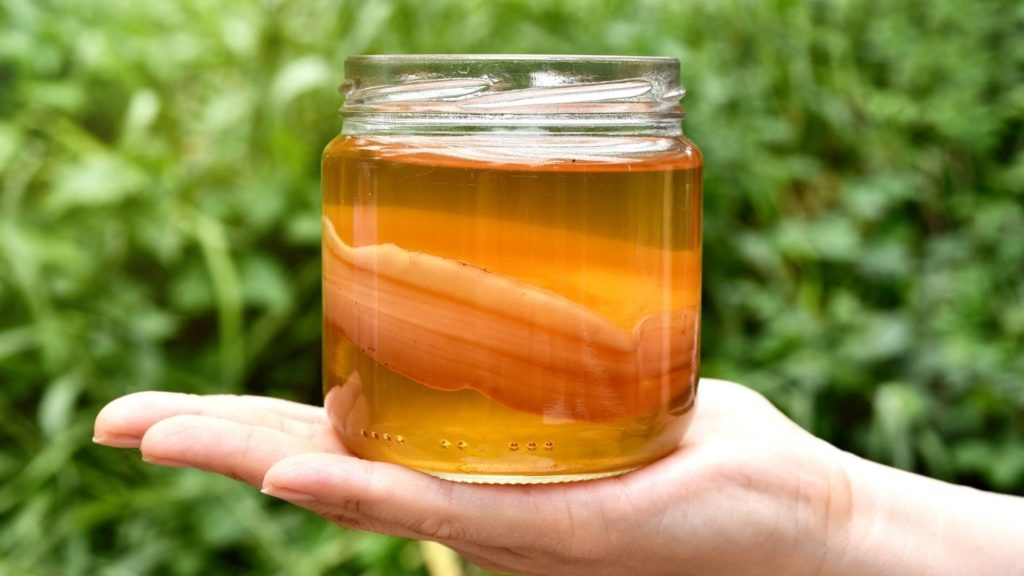Combining the sweet and tangy taste of kombucha with the pleasant bitterness of hops? It’s possible, with dry hopped kombucha!
Hops, usually reserved for beer making, give kombucha lemony, resinous, herbal, and/or earthy flavours, depending on the type of hops.
We asked Nicolas Falcimaigne, brewmaster of the Quebec microbrewery Le Caveau des Trois-Pistoles, to share with us his recipe for hop kombucha, the famous “Potion” that created a buzz this summer.
It should be noted that this recipe is for those who already have experience with making kombucha or brewing beer. Following the correct hopping times will be the key to success.
Happy discovery!
A New Hoppy Kombucha
With the Fermentation Revolution team, I recently had the chance to cast a brewer’s eye on the kombucha tradition, by devouring the excellent book “Révolution kombucha“.
It’s a whole new world that aroused my curiosity, and I developed a recipe for a 100% local hopped kombucha, which is now served in barrels at the Caveau des Trois-Pistoles!
In this recipe, the only variable is the flavouring with hops.
Our new beer, Potion #12, features the Centennial hop variety, while Potion #15 uses Chinook hops. These are just examples, as the choice of hops is almost endless!
Hops can be found in shops specialized in beer brewing.
This recipe was designed to be made with raspberry leaves and maple syrup, to only use ingredients produced in Canada. However, you will find in the notes below the equivalences for making the recipe with tea and sugar.

Recipe for Local Hop Kombucha
Equipment
- Saucepan (or small pot)
Ingredients
- 1 kombucha scoby and its liquid culture (about 350ml)
- 2 cups dried raspberry leaves (well packed)
- ¾ cup maple syrup
- ¼ cup hop pellets or leaves
- 2 cups hot water
- 2.5 L cold filtered water
Steps
Preparation of the kombucha
- Place the raspberry leaves in a saucepan and pour 500ml of boiling water.
- Let it infuse for 30 minutes, then filter and pour the infusion into the jar. Add the maple syrup and stir until dissolved.
- Add 2.5 litres of cold water.
- Add the kombucha scoby and its liquid culture.
- Cover the opening with the cloth and the rubber band.
- Let it ferment for 10 to 15 days at room temperature. Start tasting as of the 5th day. As soon as you like it, put aside 500ml of kombucha and the scoby in the fridge for the fermentation of your next kombucha.
Hopping
- Add 5g (2 tsp.) of hops to a pot with 500ml of boiling water. Let it boil for 60 minutes. Add water if necessary, to maintain the level (alpha acid isomerisation process, which brings out the bitterness of the hops).
- Remove it from the heat and add 10g (4 tsp.) of hops (this is the beginning of the aromatic hopping phase, which will bring out the aroma of the hops).
- Set a timer for 5 minutes.
- After 4 minutes, add 13g (2 tbsp.) of hops.
- Let it brew for a further minute, then filter immediately to remove the hops.
- Pour the hop infusion into the plain kombucha.
- Stir well and bottle.
- Leave the bottles in a dark place at room temperature for 3 to 4 days.
- Test the pressure and refrigerate as soon as it is fizzy.
Notes
Developing the Bitterness of Hops
Hop cones, the female flowers of the hop plant, provide both bitterness and aroma, depending on how the flavours are extracted. Finding the right balance between the two is the craft brewer’s goal!
Boiling a small quantity of hops for an hour develops the bitterness of this kombucha. This process is called “alpha acid isomerisation“, a process that is also used for brewing beer.
In the beer brewing process, the bittering hops are added while boiling the wort, before fermentation.
To make this hop kombucha, however, the hopping is done after fermentation. This difference, among others, is the reason for its particular taste.
The initial dosage during the isomerisation of the alpha acids is important, as it provides between 20 and 70 IBUs (International Bitterness Units) and will determine the bitterness of our concoction.
The amount of IBU varies according to the percentage of alpha acid of the hops being used. For example, 5g of Saaz hops with 5% alpha acids will produce less bitterness (20 IBU) than 5g of El Dorado hops with 17% (80 IBU).
Developing Hop Aromas
Aromatic hopping carried out after the isomerisation of the alpha acids is the phase that brings out the fruitier and more delicate flavours of the hops.
This process can vary in terms of type(s) of hops used, quantity, and time. Note that the longer the brew, the more delicate flavours will be preserved, but the less intense they will be.
You could also cold cold macerate the hops in the kombucha for a night in the fridge, using a food-grade nylon bag or by filtering the result. This cold infusion develops amazing aromas!
The acidic and sweet flavours of the kombucha will come out more with milder hops and stronger hops will make your potion a true IPA.
Usually, the combination of kombucha and hop acids produces a citrus flavour that will pleasantly surprise even the most sceptical.
Be careful not to overdo it, however, as too much can create a hop burn, which may or may not be appreciated by IPA drinkers. An endless world of discovery awaits you!
Choosing Your Bottles
The choice of bottles is important! Hops react to light and develop the famous skunk aroma characteristic of beers sold in transparent bottles.
This is why all beers are usually bottled in brown bottles. I strongly recommend you continue this tradition or put your elixirs away from the light as soon as they are bottled.
Happy hopping!
To develop this recipe, I was helped by my friend and brewer Jean Deschênes, producer of Les Chants du Fleuve kombucha, four houses away from me. Maybe one day, our hop kombucha Potions will be concocted in larger volumes by Jean and distributed within his network. To be continued!
Going further…
Discover other original kombucha recipes:
- White Cedar Kombucha Recipe
- 100% Local Kombucha Recipe
- Hard Kombucha Recipe
- Balsam Fir Shoot Kombucha Recipe
To create your own recipes inspired (or not!) by your favourite beers, check out our guide to flavouring your homemade kombucha and our guide to flavouring your fermented drinks with local plants.
Get started!
- Discover our homemade kombucha brewing kit
- Buy kombucha making equipment and ingredients
- Check out our 101 guide to fermenting kombucha at home
- All our homemade kombucha recipes and articles
- Read our FAQ: Is my kombucha scoby normal?

